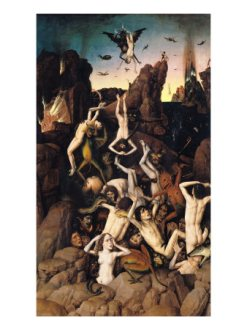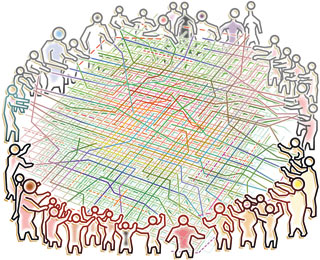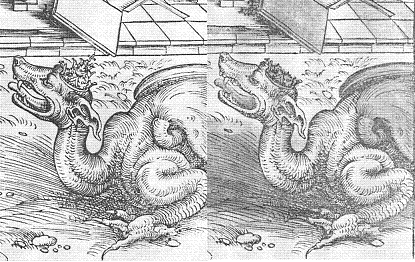Myths
& Metaphors of Private Law and Intellectual Property

Seminar
"Domain
/ Domaine"
What is the domain of the
‘public domain’?
The public
domain as a legal term in copyright, and as a broader metaphor, has
evolved to become a claim to space, to counter the overreach of
intellectual property rights. Institutes, programs,
legislative initiatives and public sector advocacy groups have
coalesced around the term to cultivate what Boyle has called an
environmentalism of the commons. But as successful
environmental groups seem to have recognized, limiting one’s
argument to the space not occupied concedes the point even before it is
made. The space claimed by the public domain may be more like
a cage than an ocean.

As
Wendy Adams noted in the last session, we have become accustomed to
a metaphor of property for intangibles that  misdescribes
the legal
right. A domain of intangibles for the public
continues the missed
metaphor. In this piece I leave aside the ambiguities inherent in the
term ‘public’, rooted in the idea public spheres
that arose in the 18th century and focus instead on the idea of domain.
misdescribes
the legal
right. A domain of intangibles for the public
continues the missed
metaphor. In this piece I leave aside the ambiguities inherent in the
term ‘public’, rooted in the idea public spheres
that arose in the 18th century and focus instead on the idea of domain.
The term ‘public
domain’ suggests some power or
dominium of the public over intellectual things. In copyright, these
things are works whose copyright has expired or lapsed, whose authors
have given the works to the public domain or works to which copyright
never attached (works that were insufficiently original). Much as with
real property, the public domain of copyright is populated by both
works of outstanding genius (like a national park) and mind-numbingly
utilitarian works (like  industrially degraded lands that no one want to
be liability for). Patented inventions whose term has expired and those
that are either such important discoveries or too unoriginal to warrant
patent protection also lie in the public domain. The
public domain of
trademarks could include almost anything forever if eventually
associated with a ware or service, including the colour orange or the
sound of a motorcycle. But a trademark may enter the public domain even
if it’s merely invented, like Kleenex or linoleum. Private,
non-commercial, educational, emergency and insubstantial uses all may
qualify as public domain uses of works that are not in the public
domain.
industrially degraded lands that no one want to
be liability for). Patented inventions whose term has expired and those
that are either such important discoveries or too unoriginal to warrant
patent protection also lie in the public domain. The
public domain of
trademarks could include almost anything forever if eventually
associated with a ware or service, including the colour orange or the
sound of a motorcycle. But a trademark may enter the public domain even
if it’s merely invented, like Kleenex or linoleum. Private,
non-commercial, educational, emergency and insubstantial uses all may
qualify as public domain uses of works that are not in the public
domain.
What becomes clear then is that the public domain,
as defined in
relation to intellectual property law, is populated by a few
spectacular and fundamental innovations, a mass of banal creations and
the non-commercial uses of IP artifacts that have not yet passed on to
the other side. But the public domain must, in reality, be much more
than this. The public’s domain is extensive, perhaps
unimaginably large. It includes the host of unknowables that exist in
the minds of creators, secret, unfixed or partially articulated. It
consists of discussion, ideas, debate, and most activity outside the
market. It includes the vast majority of works over which creators
choose not to enforce their legal rights. The fixed term of patent and
copyright, and the continued requirement for use in trademark suggest
that an IP right is a privilege that must be asserted and that cannot
be taken for granted. It occupies a discrete space for a distinct
purpose carved out of a broad undefined space of intellectual activity.
Ultimately the better name for the public domain is something more like
‘society’ or ‘culture’ or,
even, ‘life’ rather than a notion embodied in a
claim to a finite domain.
banal creations and
the non-commercial uses of IP artifacts that have not yet passed on to
the other side. But the public domain must, in reality, be much more
than this. The public’s domain is extensive, perhaps
unimaginably large. It includes the host of unknowables that exist in
the minds of creators, secret, unfixed or partially articulated. It
consists of discussion, ideas, debate, and most activity outside the
market. It includes the vast majority of works over which creators
choose not to enforce their legal rights. The fixed term of patent and
copyright, and the continued requirement for use in trademark suggest
that an IP right is a privilege that must be asserted and that cannot
be taken for granted. It occupies a discrete space for a distinct
purpose carved out of a broad undefined space of intellectual activity.
Ultimately the better name for the public domain is something more like
‘society’ or ‘culture’ or,
even, ‘life’ rather than a notion embodied in a
claim to a finite domain.
 Perhaps, a better metaphor for intellectual property’s public
domain is the concept of heaven (or hell, if you’re an IP
lawyer). It requires a belief that IP rights are born, exist and when
they die, their core moves on to a better place. Like heaven, IP rights
are based on a faith: that otherwise non-excludable goods can in fact
be exclusive if we all act as though they are. IP lawyers fight to
ensure works don’t ‘fall’ into the public
domain, be it through over-broad patent claims, substantial copying or
trade-mark dilution. But, once the IP departs its legal shell it is
admitted to the public domain; while the place may get a bit crowded,
all are accounted for.
Perhaps, a better metaphor for intellectual property’s public
domain is the concept of heaven (or hell, if you’re an IP
lawyer). It requires a belief that IP rights are born, exist and when
they die, their core moves on to a better place. Like heaven, IP rights
are based on a faith: that otherwise non-excludable goods can in fact
be exclusive if we all act as though they are. IP lawyers fight to
ensure works don’t ‘fall’ into the public
domain, be it through over-broad patent claims, substantial copying or
trade-mark dilution. But, once the IP departs its legal shell it is
admitted to the public domain; while the place may get a bit crowded,
all are accounted for.
That this public domain is as illusory as IP  rights seems clear. But I
would argue that the idea of the public domain itself is pernicious and
harmful; its existence and the knowability of its contents validates
the precursor claim to right. The end of IP term becomes a death; the
immense breadth of the public domain becomes clouded by counting its
resurrected souls. Further, this individualistic bean-counting masks
the fuzzy, hybrid and interstitial nature of cultural and technological
creation potentially impoverishing our conception of
‘life’.
rights seems clear. But I
would argue that the idea of the public domain itself is pernicious and
harmful; its existence and the knowability of its contents validates
the precursor claim to right. The end of IP term becomes a death; the
immense breadth of the public domain becomes clouded by counting its
resurrected souls. Further, this individualistic bean-counting masks
the fuzzy, hybrid and interstitial nature of cultural and technological
creation potentially impoverishing our conception of
‘life’.
Lawyers have been creating legal documents called
public domain
dedications which allow  rights holders to give their works to the
public domain. This effort has two main goals: to expand the public
domain with more certainty and to create a culture of public domain
dedication. But do we really need a licence to do that? Society has
functioned for centuries on the notion that most disclosed ideas are
free to use so long as you recognize a creator where appropriate,
don’t profit in ways that mean she can’t and avoid
mishandling the work. Intellectual works live in the public domain.
While watching IP rights we drove into the free culture cul-de-sac.
Populating the public domain is as harmful as limiting intellectual
works through rights; it prioritizes rights over uses, inverting the
presumption that all things are free until proven otherwise, forgetting
that IP rests on the grant of rights in a shared delusion.
rights holders to give their works to the
public domain. This effort has two main goals: to expand the public
domain with more certainty and to create a culture of public domain
dedication. But do we really need a licence to do that? Society has
functioned for centuries on the notion that most disclosed ideas are
free to use so long as you recognize a creator where appropriate,
don’t profit in ways that mean she can’t and avoid
mishandling the work. Intellectual works live in the public domain.
While watching IP rights we drove into the free culture cul-de-sac.
Populating the public domain is as harmful as limiting intellectual
works through rights; it prioritizes rights over uses, inverting the
presumption that all things are free until proven otherwise, forgetting
that IP rests on the grant of rights in a shared delusion.
Tina Piper
Your
comments / Vos commentaires (2)
It takes different forms in the times of the internet, yet it is hardly new that a creator is torn between wishing her creations to be as widely available as possible (and thus benefit as many people as possible), and keeping some minimal control over their reuse and alteration (the motive for “creative commons licenses”).
Martin Luther produced a translation of the Bible into popular German, with the aim of freeing the text of the holy book and its interpretation into a public domain of the common folk, beyond the gate-keeping of the Church and the erudite classes. Yet Luther took care to accompany the text with his own “inspired” commentaries and, even more importantly for his target audience, the text was accompanied by illustrations to vividly convey his perspective.
There was no enforceable mechanism of author’s copyright in place. As soon as they were on the market, Luther’s works were quickly reprinted by all sorts of print-shops, like those of any other popular or controversial author of the time. The imperatives of the market meant that some versions of the translation were quickly amended to harmonize with Catholic orthodoxy. The illustrations naturally also gained this adjustment.
For example, chapter eleven of the Book of Revelations tells of two of God’s witnesses and of  “the beast that comes up out of the abyss, makes war with them, and overcomes them, and kills them”. The illustration of this, as first printed in 1522, drove home Luther’s point of view: the beast is wearing a three tiered tiara, which would have been immediately seen as the symbol (if not the trademark) of the papacy.
“the beast that comes up out of the abyss, makes war with them, and overcomes them, and kills them”. The illustration of this, as first printed in 1522, drove home Luther’s point of view: the beast is wearing a three tiered tiara, which would have been immediately seen as the symbol (if not the trademark) of the papacy.
And yet here is a sanitized version of the same illustration, from an adjusted “version” of Luther’s translation printed in 1527 in the Catholic state of Saxony.
 Luther’s reaction to the highjackings of “his” bible was to storm against them in print, but also to deploy a “trademark” of his own, the now famous “Luther” rose. This symbol was to be included as an authenticating mark in authorized printings of Luther’s works. The rose was rarely forged, although only moral constraints bound printers to respect it. And it did not hinder the flood of unauthorized reprintings, nor apparently their popularity among buyers.
Luther’s reaction to the highjackings of “his” bible was to storm against them in print, but also to deploy a “trademark” of his own, the now famous “Luther” rose. This symbol was to be included as an authenticating mark in authorized printings of Luther’s works. The rose was rarely forged, although only moral constraints bound printers to respect it. And it did not hinder the flood of unauthorized reprintings, nor apparently their popularity among buyers.
Blake Methven
 L’optique qui voit dans la protection la norme et dans le
domaine public l’exception va peut-être
d’elle-même, une fois que nous nous voyons
simplement comme des consommateurs passifs de la culture. Le domaine
public serait en quelque sorte un dépotoir de
matières usées (et laissées pour
compte).
L’optique qui voit dans la protection la norme et dans le
domaine public l’exception va peut-être
d’elle-même, une fois que nous nous voyons
simplement comme des consommateurs passifs de la culture. Le domaine
public serait en quelque sorte un dépotoir de
matières usées (et laissées pour
compte).
La vocation de la protection des droits d’auteurs est
d’inciter la création d’œuvres
d’expression originale. Ces créations cueillent
leurs ingrédients dans le domaine public. Donc un
renouveau continuel du domaine public, tant par l’expiration
des droits d’auteur que par les apports libres des
créateurs, est un élément essentiel du
marché en vertu duquel la société
accorde ces droits.
Une fois que nous nous verrons comme co-créateurs de notre
culture, nous verrons du même coup la
nécessité de garder un sain équilibre
entre le trésor commun du domaine public et la protection
temporaire et motivée du droit d’auteur.
Pierre Bouchard
misdescribes the legal right. A domain of intangibles for the public continues the missed metaphor. In this piece I leave aside the ambiguities inherent in the term ‘public’, rooted in the idea public spheres that arose in the 18th century and focus instead on the idea of domain.
industrially degraded lands that no one want to be liability for). Patented inventions whose term has expired and those that are either such important discoveries or too unoriginal to warrant patent protection also lie in the public domain. The public domain of trademarks could include almost anything forever if eventually associated with a ware or service, including the colour orange or the sound of a motorcycle. But a trademark may enter the public domain even if it’s merely invented, like Kleenex or linoleum. Private, non-commercial, educational, emergency and insubstantial uses all may qualify as public domain uses of works that are not in the public domain.
banal creations and the non-commercial uses of IP artifacts that have not yet passed on to the other side. But the public domain must, in reality, be much more than this. The public’s domain is extensive, perhaps unimaginably large. It includes the host of unknowables that exist in the minds of creators, secret, unfixed or partially articulated. It consists of discussion, ideas, debate, and most activity outside the market. It includes the vast majority of works over which creators choose not to enforce their legal rights. The fixed term of patent and copyright, and the continued requirement for use in trademark suggest that an IP right is a privilege that must be asserted and that cannot be taken for granted. It occupies a discrete space for a distinct purpose carved out of a broad undefined space of intellectual activity. Ultimately the better name for the public domain is something more like ‘society’ or ‘culture’ or, even, ‘life’ rather than a notion embodied in a claim to a finite domain.
Perhaps, a better metaphor for intellectual property’s public domain is the concept of heaven (or hell, if you’re an IP lawyer). It requires a belief that IP rights are born, exist and when they die, their core moves on to a better place. Like heaven, IP rights are based on a faith: that otherwise non-excludable goods can in fact be exclusive if we all act as though they are. IP lawyers fight to ensure works don’t ‘fall’ into the public domain, be it through over-broad patent claims, substantial copying or trade-mark dilution. But, once the IP departs its legal shell it is admitted to the public domain; while the place may get a bit crowded, all are accounted for.
rights seems clear. But I would argue that the idea of the public domain itself is pernicious and harmful; its existence and the knowability of its contents validates the precursor claim to right. The end of IP term becomes a death; the immense breadth of the public domain becomes clouded by counting its resurrected souls. Further, this individualistic bean-counting masks the fuzzy, hybrid and interstitial nature of cultural and technological creation potentially impoverishing our conception of ‘life’.
rights holders to give their works to the public domain. This effort has two main goals: to expand the public domain with more certainty and to create a culture of public domain dedication. But do we really need a licence to do that? Society has functioned for centuries on the notion that most disclosed ideas are free to use so long as you recognize a creator where appropriate, don’t profit in ways that mean she can’t and avoid mishandling the work. Intellectual works live in the public domain. While watching IP rights we drove into the free culture cul-de-sac. Populating the public domain is as harmful as limiting intellectual works through rights; it prioritizes rights over uses, inverting the presumption that all things are free until proven otherwise, forgetting that IP rests on the grant of rights in a shared delusion.
“the beast that comes up out of the abyss, makes war with them, and overcomes them, and kills them”. The illustration of this, as first printed in 1522, drove home Luther’s point of view: the beast is wearing a three tiered tiara, which would have been immediately seen as the symbol (if not the trademark) of the papacy.
Luther’s reaction to the highjackings of “his” bible was to storm against them in print, but also to deploy a “trademark” of his own, the now famous “Luther” rose. This symbol was to be included as an authenticating mark in authorized printings of Luther’s works. The rose was rarely forged, although only moral constraints bound printers to respect it. And it did not hinder the flood of unauthorized reprintings, nor apparently their popularity among buyers.
L’optique qui voit dans la protection la norme et dans le domaine public l’exception va peut-être d’elle-même, une fois que nous nous voyons simplement comme des consommateurs passifs de la culture. Le domaine public serait en quelque sorte un dépotoir de matières usées (et laissées pour compte).

